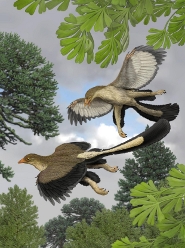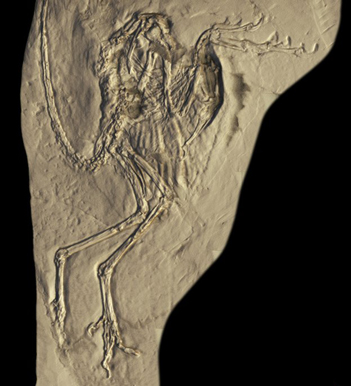Could Archaeopteryx Fly? That is an Excellent Question!
Seeing Archaeopteryx in a New Light (Literally)
A joint team from the European Synchrotron Radiation Facility (Grenoble, France), the Solnhofen Museum (southern Germany), the Paul Scherrer Institute (Switzerland) and the Palacký University (Czech Republic) have been collaborating on a piece of ground-breaking research in order to assess the flight capabilities of Archaeopteryx. Ever since the first fossil of this ancient, feathered creature were found amongst the finely grained lithographic limestone strata of Solnhofen, scientists have speculated on whether this “dino-bird” could fly.
Archaeopteryx lithographica
Archaeopteryx fossil material is extremely rare, for much of the known history of Archaeopteryx (A. lithographica), its holotype material consisted of the impression of a single feather. In all, thirteen fossils ascribed to Archaeopteryx have now been found (if you include the feather specimen), they represent material that is regarded by many palaeontologists as some of the most important vertebrate fossils discovered to date. Archaeopteryx is viewed as a “transitional fossil” it shows anatomical evidence of both dinosaurs and birds. Here is a dinosaur with feathers or if you prefer, the fossils represent a bird with teeth!
But could it fly?
The Subject of Intense International Study

Picture credit: Carl Buell
Few Fossils to Study
With so few fossils of Archaeopteryx to study, answering this fundamental question has proved extremely difficult. Palaeontologists from the Natural History Museum (London), using the “London specimen”, now regarded as the holotype after a ruling in 2011 by the International Commission on Zoological Nomenclature (ICZN), have used X-rays to uncover more information, but the matrix surrounding the fossil has meant that the slabs of limestone in the biggest specimens are too large to be rotated in standard CT scanners.
To read more about the work on Archaeopteryx by the Natural History Museum: Let’s Hear it for Archaeopteryx.
Using a Synchrotron
Other techniques would prove too destructive, so most of the research carried out to date has involved a close up analysis of the surface of the fossil. However, the use of intense X-ray beams generated by a synchrotron has enabled this European team to probe the depths of Archaeopteryx revealing details of the feathers and vertebrae not seen before. An X-ray scattering technique employed at the European Synchrotron Radiation Facility (ESRF), has permitted researchers to see images from deep within the rock entombing the 150-million-year-old creature. A beam of intense light called a slice beam is projected at the fossil, this beam slowly travels down the mounted specimen permitting the X-rays that have been emitted to penetrate deep inside the rock.
As the X-rays are diffused by the substrate and fossil their rate of diffusion can be detected by a camera obscura system, a pin hole within a large sheet of lead, which relays this data to detection software that can produce a computer generated three dimensional image.
A Non-destructive Technique
This is a non-destructive technique that permits scientists to see right inside the fossil and pick up details not revealed on the surface. This new method of studying life in the past was tried on two specimens of Archaeopteryx, an almost complete specimen known as the Wellnhoferia grandis specimen and an isolated fragment of wing that had not been too distorted or crushed as a result of the fossilisation process.
The Wellnhoferia Archaeopteryx Specimen Used in the Analysis

Picture credit: Pascal Goetgheluck
Could Archaeopteryx Fly?
The Wellnhoferia Archaeopteryx has had a chequered history. Originally it had been described as a fossil of the small Jurassic theropod Compsognathus, however, a detailed analysis led to it being declared a new genus of bird and the genus Wellnhoferia (W. grandis) was established. Further research led to the specimen being referred back to Archaeopteryx, it represents the largest individual known to science with a wingspan of around fifty centimetres. It is likely to be one of the show piece fossils on display when the Solnhofen museum re-opens today (24th May), after six months of renovation.
One of the Three-Dimensional Images Generated

Picture credit: European Radiation Synchrotron Facility
This results of this study will permit scientists to see previously hidden anatomical features of Archaeopteryx which may finally resolve the issue as to whether this creature could fly or not. It will also contribute significantly to the current knowledge of avian evolution. It is very likely that other fossil specimens will be analysed using this methodology.
The Research Team Photographed Next to the Wellnhoferia Specimen

Picture credit: Pascal Goetgheluck
Papo of France recently introduced a very colourful model of Archaeopteryx (A. lithographica), it has been heralded as one of the best models of this prehistoric animal ever made.
The Papo Archaeopteryx Prehistoric Animal Model

Picture credit: Everything Dinosaur
To view the Papo range of prehistoric animal models, including theropod dinosaur replicas: Papo Prehistoric Animal Models and Figures.

